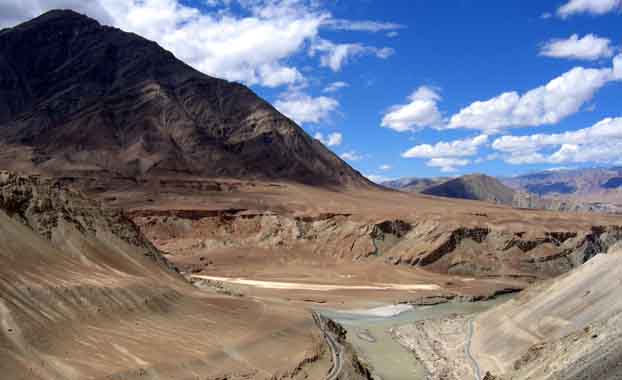|
Zanskar
About 20 kms. South of Rangdum
stands the Pazila watershed across which lies Zanskar, the most isolated
of all the trans Himalayan Valleys. The Panzila Top (4401 m) is the picturesque
tableland adorned with two small alpine lakes and surrounded by snow covered
peaks. As the Zanskar road winds down the steep slopes of the watershed
to the head of the Stod Valley, one of Zanskar's main tributary valleys,
the majestic "Drang-Drung" glacier looms into full view. A long and winding
river of ice and snow, the Drang-Drung" is perhaps the largest glacier
in Ladakh, outside the Siachen formation. It is from the cliff-like snout
of this extensive glacier that the Stod or Doda River, the main tributary
of river Zanskar, rises.
 Zanskar comprises a tri-armed
valley system lying between the Great Himalayan Range and the Zanskar mountain;
The three arms radiate star-like towards the west, north and south from
a wide central expanse where the region's two principal drainage's meet
to form the main Zanskar River. It is mainly along the course of this valley
system that the region's 10,000 strong, mainly Buddhists population lives.
Spread over an estimated geographical area of 5000 sq. kms. High rise,
mountains and deep gorges surround Zanskar. The area remains inaccessible
for nearly 8 months a year due to heavy snowfall resulting in closure of
all the access passes, including the Penzi-la. To-day, Zanskar has the
distinction of being the least interfered with microcosms of Ladakh, and
one of the last few surviving cultural satellites of Tibet. Within the
mountain ramparts of this lost Shangrila stand a number of ancient yet
active monastic establishments. Some of these religious foundations have
evolved around remote meditation caves believed to have been used by a
succession of famous Buddhist saints for prolonged meditation in pursuit
of knowledge and enlightenment.
Zanskar comprises a tri-armed
valley system lying between the Great Himalayan Range and the Zanskar mountain;
The three arms radiate star-like towards the west, north and south from
a wide central expanse where the region's two principal drainage's meet
to form the main Zanskar River. It is mainly along the course of this valley
system that the region's 10,000 strong, mainly Buddhists population lives.
Spread over an estimated geographical area of 5000 sq. kms. High rise,
mountains and deep gorges surround Zanskar. The area remains inaccessible
for nearly 8 months a year due to heavy snowfall resulting in closure of
all the access passes, including the Penzi-la. To-day, Zanskar has the
distinction of being the least interfered with microcosms of Ladakh, and
one of the last few surviving cultural satellites of Tibet. Within the
mountain ramparts of this lost Shangrila stand a number of ancient yet
active monastic establishments. Some of these religious foundations have
evolved around remote meditation caves believed to have been used by a
succession of famous Buddhist saints for prolonged meditation in pursuit
of knowledge and enlightenment.
The 240 km long Kargil-Padun
road, of which the first 90 km stretch is paved, remains opened from around
mid July to early November. In June, the summer is at its height in the
region and the climate is ideal for trekking along the route free from
vehicular traffic of any kind and when the countryside is freshly rejuvenated
into life after months of frigid dormancy.
....Back
All
rights reserved. 
 |







